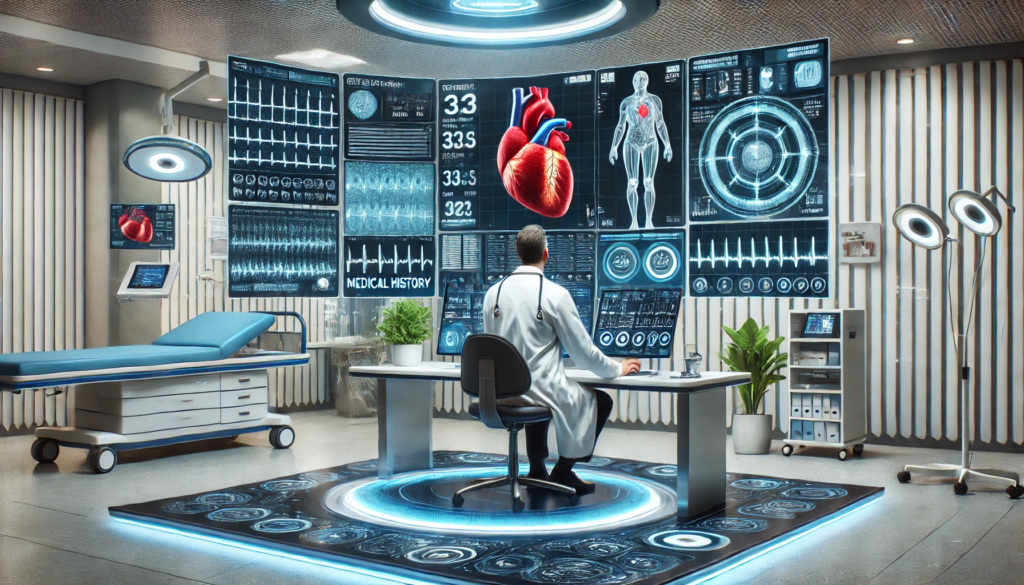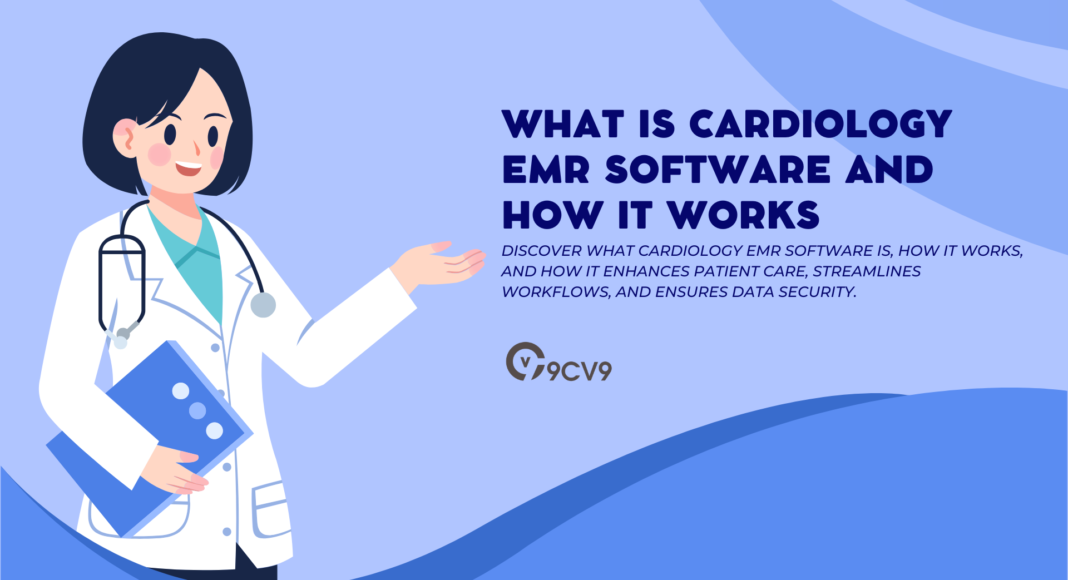Key Takeaways
- Cardiology EMR software streamlines patient data management, integrates diagnostic tools, and enhances workflow efficiency for cardiologists.
- Key features include real-time access to patient histories, automated documentation, and seamless interoperability with medical devices.
- Implementing EMR software improves accuracy, ensures regulatory compliance, and enhances patient care with AI-driven analytics and telehealth support.
In today’s fast-paced and data-driven healthcare environment, technology is revolutionizing how healthcare providers manage patient care and streamline administrative tasks.
One of the most significant advancements in healthcare technology is the adoption of Electronic Medical Records (EMR) software.
While EMRs are widely used across various medical fields, cardiology requires specialized software to meet the unique demands of cardiovascular care. This is where Cardiology EMR software comes into play.

Cardiology EMR software is a tailored solution designed specifically for cardiologists and cardiovascular specialists.
It goes beyond the traditional functionalities of standard EMR systems by providing specialized features that address the complexities of heart health management, from diagnostic tests to treatment plans.
Unlike generic EMR systems, cardiology-specific EMR platforms incorporate cardiovascular health data, enabling healthcare providers to manage, monitor, and analyze a patient’s heart health with precision and efficiency.
The growing need for accurate, up-to-date patient data in cardiology has led to an increased adoption of these advanced systems.
Cardiology EMR software allows practitioners to access comprehensive patient information in real time, enabling more informed decision-making and improving overall patient outcomes.
Additionally, it facilitates seamless communication between cardiologists, healthcare teams, and patients, improving the coordination of care and reducing the risk of medical errors.
As healthcare continues to evolve, the role of EMR software in improving patient care and clinical outcomes cannot be overstated.
The use of cardiology-specific EMR software not only supports the management of patient records but also enhances workflow, ensures better patient engagement, and streamlines the delivery of care.
In this blog, we will explore what cardiology EMR software is, how it works, and the benefits it brings to the healthcare ecosystem.
We will also delve into the key features and components of these systems, providing a comprehensive understanding of why they are essential tools for cardiologists and cardiovascular healthcare providers.
By leveraging specialized technology, cardiologists can offer more accurate diagnoses, improve patient management, and stay ahead in the ever-evolving field of heart health.
Through this guide, you’ll gain a deeper understanding of how cardiology EMR software enhances the quality of care, optimizes clinical workflows, and drives innovations in cardiovascular healthcare.
Before we venture further into this article, we would like to share who we are and what we do.
About 9cv9
9cv9 is a business tech startup based in Singapore and Asia, with a strong presence all over the world.
With over nine years of startup and business experience, and being highly involved in connecting with thousands of companies and startups, the 9cv9 team has listed some important learning points in this overview of What is Cardiology EMR Software and How It Works.
If your company needs recruitment and headhunting services to hire top-quality employees, you can use 9cv9 headhunting and recruitment services to hire top talents and candidates. Find out more here, or send over an email to [email protected].
Or just post 1 free job posting here at 9cv9 Hiring Portal in under 10 minutes.
What is Cardiology EMR Software and How It Works
- What is Cardiology EMR Software?
- Key Components of Cardiology EMR Software
- How Does Cardiology EMR Software Work?
- Benefits of Using Cardiology EMR Software
- Challenges in Implementing Cardiology EMR Software
- Choosing the Right Cardiology EMR Software
1. What is Cardiology EMR Software?
Cardiology EMR (Electronic Medical Records) software is a specialized type of EMR designed specifically to meet the needs of cardiologists and cardiovascular specialists. Unlike general-purpose EMR systems, cardiology EMR software is built to manage the complex and dynamic nature of heart disease diagnoses, treatments, and long-term management. These systems enable healthcare providers to streamline their workflow, improve patient outcomes, and enhance collaboration across the care continuum.
Here is a deeper look into what makes cardiology EMR software unique:
1. Overview of Cardiology EMR Software
- Definition:
Cardiology EMR software is a digital platform designed to capture, store, and manage a patient’s cardiovascular health information, including medical history, diagnostic results, and treatment plans. - Purpose:
It aims to optimize clinical workflows for cardiologists by centralizing patient data, improving accuracy in diagnoses, and supporting efficient management of cardiovascular diseases (CVD). - Key Focus Areas:
- Patient management specific to cardiovascular health
- Integration of diagnostic tools and medical imaging systems
- Real-time access to patient records and treatment history
- Comprehensive tracking of long-term cardiovascular health
2. Core Features of Cardiology EMR Software
a. Cardiovascular-Specific Templates and Charts
- Customized for Cardiologists:
Cardiology EMR software comes equipped with templates and charts specifically designed for cardiovascular diseases, such as coronary artery disease, heart failure, and arrhythmias.- Example: Templates for ECG readings, echocardiogram reports, and blood pressure monitoring.
- Benefit: These tailored templates ensure that all necessary data points for heart health are captured accurately and consistently.
b. Diagnostic and Imaging Integration
- Seamless Data Integration:
Cardiology EMR software integrates with diagnostic tools like ECG machines, echocardiography, and MRI/CT scanners, providing a comprehensive view of a patient’s heart health.- Example: Integration with a Holter monitor allows continuous monitoring of a patient’s heart rhythms, which is directly uploaded into the EMR for analysis.
- Benefit: Physicians can access real-time diagnostic data alongside patient records, ensuring more accurate diagnoses and faster treatment decisions.
c. Medication and Prescription Management
- Cardiology-Focused Prescriptions:
The software offers functionality for prescribing medications that are specific to heart-related conditions, ensuring that interactions between drugs are properly managed.- Example: Prescriptions for anticoagulants, beta-blockers, and statins with automated interaction checks.
- Benefit: Automated alerts help avoid drug-to-drug interactions that could be dangerous for patients with complex cardiovascular conditions.
d. Clinical Decision Support (CDS)
- Enhanced Decision-Making:
Many cardiology EMR systems come equipped with clinical decision support tools that provide real-time suggestions based on patient data and clinical guidelines.- Example: Alerts for abnormal heart rhythm patterns or flagging abnormal lab results such as elevated cholesterol levels.
- Benefit: These tools help cardiologists make data-driven, evidence-based decisions quickly, improving patient safety and outcomes.
3. How Cardiology EMR Software Works
a. Data Entry and Patient Information Management
- Patient Record Creation:
Cardiology EMR software allows healthcare providers to input detailed patient information, such as:- Medical history, including previous heart surgeries, family history of cardiovascular disease
- Risk factors such as smoking, obesity, and high cholesterol
- Vital signs and heart health data (e.g., blood pressure, heart rate)
- Real-Time Access to Data:
Once entered, all data is immediately accessible to clinicians, enabling efficient, real-time decision-making. Cardiologists can view up-to-date patient information from any connected device, whether in the office or during hospital rounds.
b. Integration with Diagnostic Tools and Medical Imaging
- Comprehensive Patient View:
Diagnostic tools like ECG, echocardiograms, and MRI/CT scans integrate directly with the cardiology EMR, offering a holistic view of a patient’s cardiovascular health.- Example: A cardiologist can compare an electrocardiogram (ECG) result directly with the patient’s medical history and medications stored in the EMR.
- Benefit: This integration reduces the need for paper records or manual data entry, saving time and reducing errors.
c. Treatment Plan Development and Monitoring
- Tracking Treatment and Outcomes:
Cardiology EMR software helps clinicians track the progress of treatment over time, from medication regimens to lifestyle modifications.- Example: Monitoring a patient’s response to a particular heart medication over a six-month period, adjusting the dosage based on tracked results.
- Benefit: This ongoing tracking provides a continuous record of progress, ensuring that the treatment plan remains aligned with the patient’s evolving needs.
d. Collaboration Across Healthcare Teams
- Enhanced Communication:
Cardiology EMR software allows for seamless communication between different healthcare professionals involved in a patient’s care. This includes general practitioners, cardiologists, specialists, nurses, and even pharmacies.- Example: A cardiologist can instantly communicate with a patient’s primary care physician regarding a treatment modification or an urgent care decision.
- Benefit: Improved collaboration between specialists and healthcare teams results in more comprehensive care, particularly for patients with multiple co-morbidities.
4. Benefits of Cardiology EMR Software
a. Improved Patient Care
- Accurate and Timely Data:
Clinicians have immediate access to accurate, up-to-date patient data, including test results, medical histories, and diagnostic reports.- Benefit: This ensures that decisions regarding patient care are based on the most current information, leading to better treatment outcomes.
b. Enhanced Efficiency and Reduced Administrative Burden
- Automated Documentation:
Cardiology EMR systems automate documentation processes, such as note-taking and report generation, reducing the time spent on administrative tasks.- Benefit: Cardiologists can focus more on patient care rather than manual record-keeping, which enhances productivity.
c. Regulatory Compliance
- Data Security and Privacy:
Cardiology EMR software is designed with healthcare regulations, such as HIPAA (Health Insurance Portability and Accountability Act) in mind, ensuring that patient data is securely stored and transmitted.- Benefit: This ensures that sensitive patient information is protected, helping healthcare providers meet regulatory standards.
d. Enhanced Decision Support
- Clinical Alerts and Notifications:
The software’s decision support features can alert clinicians to important health risks, such as potential drug interactions, abnormal heart rhythms, or emerging cardiovascular conditions.- Example: A software alert may notify a cardiologist when a patient’s cholesterol levels reach a threshold that requires immediate intervention.
- Benefit: These built-in safeguards improve patient safety and reduce the risk of medical errors.
5. Examples of Leading Cardiology EMR Software
- Epic Systems:
Epic offers a specialized cardiology module that integrates with other hospital systems for a comprehensive patient view. It includes features for managing complex cardiology workflows, diagnostic results, and medication prescriptions. - Cerner PowerChart:
Cerner’s EMR software is widely used in cardiology clinics for managing both inpatients and outpatients. The software features heart-specific documentation templates and integrates seamlessly with diagnostic imaging systems, such as echocardiograms. - Allscripts:
Allscripts provides a cardiology-specific solution that helps clinicians track and manage cardiovascular health through specialized templates, decision support tools, and diagnostic integration.
Conclusion
Cardiology EMR software is an indispensable tool for modern cardiovascular practices. By offering tailored functionalities for heart health management, it enhances patient care, improves clinical decision-making, and optimizes the workflow within cardiology clinics. Through its integration with diagnostic tools, real-time patient data access, and enhanced collaboration across healthcare teams, cardiology EMR software ensures that heart patients receive the highest standard of care.
2. Key Components of Cardiology EMR Software
Cardiology EMR software is specifically designed to address the unique needs of cardiology practices. It integrates a wide range of specialized tools and features that streamline workflows, improve patient care, and ensure seamless collaboration among healthcare providers. These components are crucial for ensuring the system’s effectiveness in diagnosing, treating, and managing cardiovascular conditions. Below, we explore the key components of cardiology EMR software in detail:
1. Patient Management and Record-Keeping
a. Centralized Patient Data
- Unified Patient Records:
Cardiology EMR systems centralize patient information, allowing cardiologists to maintain comprehensive records of heart health. This includes:- Personal information (age, gender, contact details)
- Medical history (previous heart conditions, surgeries, etc.)
- Lifestyle information (smoking, diet, exercise habits)
- Diagnostic results (ECGs, echocardiograms, lab tests)
- Benefit:
A centralized database allows for easy access to all patient-related information, facilitating better decision-making and reducing the risk of errors.
b. Patient History and Cardiovascular Risk Assessment
- Incorporation of Risk Factors:
The software tracks patient risk factors such as hypertension, cholesterol levels, family history of heart disease, and smoking habits.- Example: When a new patient visits, the system prompts the cardiologist to enter risk factors, which automatically updates the cardiovascular risk assessment.
- Benefit:
Identifying at-risk patients early ensures preventive measures can be implemented, ultimately improving long-term outcomes.
2. Cardiovascular-Specific Documentation Tools
a. Customizable Templates for Cardiologists
- Pre-Designed Templates for Cardiology Conditions:
Cardiology EMR software includes customizable templates for various cardiovascular conditions and procedures, such as:- Coronary artery disease (CAD)
- Atrial fibrillation (AFib)
- Heart failure management
- Post-surgical follow-ups
- Benefit:
Standardized templates ensure accurate and consistent documentation across the clinic, while also improving efficiency by reducing time spent on data entry.
b. Structured and Unstructured Data Entry
- Structured Data Fields:
The software includes structured data fields for heart rate, blood pressure, ECG findings, and lab results, making it easier to analyze data over time.- Example: Cardiology EMR systems can store detailed measurements such as ejection fraction or heart wall thickness.
- Unstructured Notes and Narratives:
Cardiologists can also input unstructured notes, such as observations or concerns that don’t fit into structured fields.- Example: A cardiologist might write detailed notes on a patient’s post-operative recovery in a free-text format.
- Benefit:
Structured data makes it easy to analyze trends, while unstructured notes offer flexibility in documenting complex cases.
3. Diagnostic and Imaging Integration
a. Integration with Diagnostic Tools
- Linking ECG and EKG Data:
Cardiology EMR systems are equipped to integrate with diagnostic equipment such as electrocardiograms (ECG), echocardiograms, and Holter monitors.- Example: An ECG result can be directly uploaded into the EMR, where it is automatically matched to the corresponding patient record.
- Benefit:
This integration ensures that diagnostic data is always up-to-date and linked to patient records, reducing manual data entry and the risk of errors.
b. Medical Imaging Integration
- Cross-System Integration for Imaging:
Cardiology EMR software often integrates with Picture Archiving and Communication Systems (PACS) for storing and viewing medical imaging results, such as:- Echocardiograms
- CT scans and MRIs
- Angiograms
- Benefit:
With direct access to medical imaging from within the EMR system, cardiologists can make faster, more informed decisions regarding treatment plans.
4. Clinical Decision Support Tools (CDS)
a. Real-Time Alerts and Notifications
- Clinical Alerts:
Cardiology EMR systems include decision support tools that offer real-time alerts for abnormalities in patient data.- Example: An alert for high blood pressure or abnormal heart rhythms, which can signal the need for immediate intervention.
- Benefit:
Real-time alerts help reduce medical errors by notifying clinicians of critical changes in patient conditions that require prompt action.
b. Evidence-Based Guidelines
- Integration with Clinical Guidelines:
Many cardiology EMR systems incorporate evidence-based clinical guidelines to help cardiologists make informed decisions.- Example: For patients with heart failure, the EMR may suggest treatment protocols or recommend tests based on established guidelines (e.g., ACC/AHA heart failure management guidelines).
- Benefit:
Integration with guidelines helps standardize care, ensuring that patients receive the most up-to-date and evidence-backed treatments.
5. Medication Management and E-Prescribing
a. Cardiology-Specific Drug Database
- Comprehensive Medication List:
Cardiology EMR systems include a database of medications commonly prescribed in cardiovascular care, including:- Antihypertensive drugs (e.g., ACE inhibitors, beta-blockers)
- Anticoagulants (e.g., warfarin, direct oral anticoagulants)
- Cholesterol-lowering agents (e.g., statins)
- Benefit:
The system automatically cross-references prescribed medications with patient records, ensuring accuracy in drug choice and dosage.
b. E-Prescribing and Medication Alerts
- Electronic Prescription Management:
Cardiology EMR software facilitates e-prescribing, allowing cardiologists to send prescriptions directly to pharmacies.- Example: If a medication needs to be adjusted or renewed, the cardiologist can quickly modify and send the prescription without needing to handwrite it.
- Benefit:
E-prescribing reduces errors, enhances convenience for patients, and ensures that medications are dispensed accurately.
c. Drug Interaction and Allergy Alerts
- Automated Alerts for Drug Interactions:
Cardiology EMR systems automatically flag potential drug interactions or allergies that could pose a risk to the patient.- Example: A cardiologist prescribing a statin for cholesterol may receive a warning if the patient is already taking a medication that interacts with statins.
- Benefit:
This feature enhances patient safety by preventing dangerous drug interactions and allergic reactions.
6. Reporting and Analytics
a. Patient Health Dashboards
- Comprehensive Dashboards for Cardiologists:
Cardiology EMR software typically includes patient health dashboards that provide an overview of a patient’s cardiovascular status, including:- Blood pressure readings
- Lipid panel results
- Heart function metrics (e.g., ejection fraction)
- Benefit:
Dashboards offer cardiologists a snapshot of patient health, allowing for quick assessments and decision-making.
b. Predictive Analytics and Risk Scoring
- Predictive Tools for Cardiovascular Risk:
Advanced cardiology EMR systems incorporate predictive analytics to assess a patient’s long-term risk for cardiovascular events.- Example: Using algorithms to predict the likelihood of a heart attack based on factors like cholesterol levels, family history, and lifestyle.
- Benefit:
Risk scoring tools enable clinicians to identify high-risk patients early and prioritize preventive care.
7. Patient Portal and Engagement Tools
a. Secure Patient Communication
- Access to Records:
Many cardiology EMR systems feature a patient portal that gives patients secure access to their cardiovascular health records, lab results, and upcoming appointments.- Example: A patient can view their latest ECG results and communicate with their cardiologist through the portal.
- Benefit:
The portal promotes better engagement by allowing patients to be more involved in their own care and access their health information remotely.
b. Appointment Scheduling and Reminders
- Automated Appointment Management:
Cardiology EMR systems often include tools for scheduling patient appointments and sending automatic reminders for follow-up visits or tests.- Example: Patients receive an automated reminder for their next echocardiogram or stress test.
- Benefit:
Automated scheduling and reminders help reduce missed appointments, leading to better patient management.
8. Data Security and Compliance Features
a. HIPAA Compliance
- Patient Privacy and Security:
Cardiology EMR software ensures compliance with healthcare regulations like HIPAA (Health Insurance Portability and Accountability Act) by incorporating robust encryption methods and secure access controls.- Example: Two-factor authentication for cardiologists accessing sensitive patient information.
- Benefit:
These security features protect patient privacy and ensure the system meets regulatory standards, preventing data breaches.
b. Backup and Disaster Recovery
- Data Backup Systems:
Regular data backups ensure that patient records are safely stored and can be recovered in case of a system failure or disaster.- Example: Cloud-based systems that automatically back up patient data to secure servers.
- Benefit:
Reliable backup systems provide continuity of care and prevent data loss in the event of technical issues.
Conclusion
The key components of cardiology EMR software provide the backbone for efficient, accurate, and high-quality care in cardiology practices. With features such as diagnostic integration, clinical decision support, medication management, and patient engagement tools, cardiology EMR systems help cardiologists provide timely and effective treatments, ultimately improving patient outcomes. These features are not just beneficial for clinical workflows but also for enhancing patient safety, privacy, and long-term care management.
3. How Does Cardiology EMR Software Work?
Cardiology EMR (Electronic Medical Record) software is designed to streamline the management of patient health records and optimize workflows in cardiology practices. By integrating various tools and systems, it allows cardiologists to efficiently diagnose, treat, and manage cardiovascular diseases, all while ensuring secure and accurate record-keeping. Below, we will delve into the intricate workings of cardiology EMR software and highlight the processes and functionalities that make it a vital component of modern cardiology practices.
1. Data Entry and Patient Record Creation
a. Initial Patient Data Collection
- Input of Basic Information:
The cardiology EMR system begins by capturing essential patient information such as:- Demographics (name, age, gender, contact details)
- Medical history (previous surgeries, conditions, family history of heart diseases)
- Lifestyle information (smoking, alcohol use, exercise routines)
- Example:
A new patient arrives with a history of hypertension. The cardiologist enters this information into the EMR, automatically updating the patient’s risk assessment for cardiovascular events. - Benefit:
This process ensures that all patient information is centralized, providing easy access and reducing the risk of errors in diagnosis or treatment planning.
b. Importing Historical Data
- Integration with Other Systems:
Cardiology EMR systems often allow the import of historical data from other healthcare facilities, previous health records, or external diagnostic equipment such as ECGs or lab results.- Example: An ECG from a prior visit or another facility can be imported directly into the patient’s EMR for easy reference.
- Benefit:
This feature ensures continuity of care, allowing clinicians to view the patient’s complete medical history, even if they are not the original healthcare provider.
2. Integration with Diagnostic Tools
a. ECG and EKG Data Integration
- Seamless Data Flow from Diagnostic Equipment:
Cardiology EMR systems are designed to integrate with diagnostic tools like electrocardiograms (ECGs) and electrocardiograph machines (EKGs).- Example: Once an ECG test is performed, the cardiogram is automatically transferred to the EMR system, attached to the patient’s record for further review.
- Benefit:
This automation reduces manual data entry and ensures that diagnostic information is readily available in the patient’s file for better clinical decision-making.
b. Imaging Integration (PACS)
- Incorporating Medical Imaging:
Cardiology EMR software integrates with Picture Archiving and Communication Systems (PACS) for seamless access to medical images such as echocardiograms, CT scans, and angiograms.- Example: A cardiologist reviewing an angiogram on PACS can quickly switch to the patient’s medical record within the EMR software, ensuring complete context while making clinical decisions.
- Benefit:
The integration of medical imaging into the EMR system allows cardiologists to view both diagnostic images and patient records in one location, improving efficiency and decision-making.
3. Clinical Decision Support
a. Real-Time Alerts and Notifications
- Automated Alerts Based on Patient Data:
Cardiology EMR systems incorporate decision support tools that provide real-time alerts for abnormal patient data, such as:- High blood pressure readings
- Irregular heart rhythms (e.g., atrial fibrillation)
- Abnormal ECG readings
- Example: A cardiologist receives an alert if a patient’s ECG shows signs of arrhythmia or if their blood pressure readings are dangerously high.
- Benefit:
These automated alerts help prevent potential medical errors, ensuring that clinicians act on critical findings promptly.
b. Evidence-Based Recommendations
- Guidelines Integration:
Cardiology EMR systems integrate with clinical guidelines such as those from the American College of Cardiology (ACC) or the American Heart Association (AHA). Based on the patient’s condition, the system suggests evidence-based treatment protocols.- Example: If a patient is diagnosed with heart failure, the system may recommend an evidence-based treatment plan including medications and lifestyle changes per the latest guidelines.
- Benefit:
Integration with clinical guidelines ensures that cardiologists are providing care that is aligned with the latest research and best practices, improving patient outcomes.
4. Medication Management and E-Prescribing
a. Automated Medication Prescriptions
- Drug Selection from Cardiology-Specific Database:
The EMR system features a cardiology-specific medication database, which allows cardiologists to prescribe medications directly from the system.- Example: A cardiologist prescribing a statin for a patient with high cholesterol can select the appropriate drug, ensuring it’s suitable for the patient’s health profile.
- Benefit:
This ensures accurate drug selection and minimizes errors in prescribing medications that could interact with the patient’s existing prescriptions.
b. E-Prescribing and Medication Tracking
- Sending Prescriptions Electronically:
Cardiology EMR software allows for e-prescribing, which enables clinicians to send prescriptions directly to the patient’s pharmacy electronically.- Example: The cardiologist electronically sends a prescription for anticoagulants to a pharmacy, reducing wait times and errors associated with handwritten prescriptions.
- Benefit:
E-prescribing improves efficiency, reduces medication errors, and provides real-time tracking of prescription fulfillment.
5. Data Analysis and Reporting
a. Patient Health Dashboards
- Comprehensive Overview of Patient Health:
The system includes patient health dashboards, which provide a visual representation of critical metrics such as:- Blood pressure readings
- Cholesterol levels
- ECG trends
- Example: A cardiologist uses the dashboard to track a patient’s blood pressure over time, making it easier to assess the effectiveness of prescribed treatment.
- Benefit:
Dashboards allow for quick, data-driven decision-making, ensuring that the cardiologist has a holistic view of the patient’s health at a glance.
b. Predictive Analytics for Risk Assessment
- Risk Scoring and Predictive Tools:
Many cardiology EMR systems incorporate predictive analytics tools that assess a patient’s long-term cardiovascular risk. These tools use algorithms to generate risk scores based on:- Family history
- Lifestyle factors (smoking, diet, exercise)
- Blood pressure, cholesterol, and other clinical data
- Example: A patient with a high risk of cardiovascular events may be flagged by the predictive model, prompting the cardiologist to take preventive measures or recommend additional testing.
- Benefit:
Predictive analytics help identify at-risk patients early, allowing for proactive care that can mitigate the likelihood of adverse cardiovascular events.
6. Patient Communication and Engagement
a. Patient Portal Integration
- Access to Health Records:
Cardiology EMR systems often come with a secure patient portal that allows patients to access their health records, view test results, and communicate with their cardiologists.- Example: A patient can log into the portal to check the results of a recent echocardiogram and schedule their next follow-up appointment.
- Benefit:
Patient portals encourage engagement, improve patient satisfaction, and provide patients with direct access to their health information, fostering more collaborative care.
b. Appointment Scheduling and Reminders
- Automated Appointment Management:
The system automates appointment scheduling, including sending reminders to patients about upcoming appointments, procedures, or tests.- Example: A patient receives a reminder a week before their scheduled stress test, reducing the chance of missed appointments.
- Benefit:
Automated scheduling reduces administrative workload and ensures patients adhere to their treatment plans by attending necessary appointments and tests.
7. Security and Compliance
a. HIPAA Compliance
- Data Security and Encryption:
Cardiology EMR systems adhere to HIPAA (Health Insurance Portability and Accountability Act) regulations, ensuring that patient information is securely stored and transmitted.- Example: When a cardiologist accesses a patient’s record, the system employs encryption to protect the information from unauthorized access.
- Benefit:
Ensuring compliance with HIPAA protects patient privacy and prevents data breaches, which are crucial for maintaining trust and avoiding legal penalties.
b. Backup and Disaster Recovery
- Data Redundancy and Backup:
Regular backups of patient data ensure that information is not lost in the event of a system failure. Many systems use cloud-based storage for additional security and redundancy.- Example: In case of a server failure, the data can be restored from secure cloud backups to ensure continuity of care.
- Benefit:
Reliable backup systems ensure that no patient data is lost and provide a disaster recovery plan to minimize system downtime.
Conclusion
Cardiology EMR software works by integrating essential tools for data entry, diagnostic integration, decision support, medication management, patient communication, and more. Through automated workflows and seamless communication between different systems, it helps cardiologists provide efficient, accurate, and patient-centered care. With its ability to integrate diagnostic data, generate real-time alerts, provide predictive analytics, and ensure patient engagement, cardiology EMR software is indispensable in modern cardiology practices, improving both the quality of care and patient outcomes.
4. Benefits of Using Cardiology EMR Software
Cardiology EMR (Electronic Medical Record) software is a game-changer for cardiology practices, streamlining workflows, enhancing patient care, and improving efficiency. With its specialized features tailored for cardiovascular healthcare, it enables cardiologists to manage patient records, analyze diagnostic data, and make informed decisions seamlessly. Below, we explore the key benefits of using cardiology EMR software and how it optimizes the clinical and administrative aspects of cardiology practices.
1. Improved Efficiency and Workflow Optimization
a. Automated Documentation and Record-Keeping
- Eliminates manual paperwork by digitizing patient records and making them easily accessible.
- Reduces administrative burden for healthcare providers, allowing more time for patient care.
- Example: Instead of manually writing reports for echocardiogram results, the software automatically generates reports, reducing documentation time.
b. Faster Access to Patient Data
- Provides instant access to comprehensive patient records, including medical history, diagnostic reports, and prescriptions.
- Facilitates quick retrieval of previous ECGs, stress tests, and angiograms, improving decision-making.
- Example: A cardiologist reviewing a patient’s historical ECG trends can quickly identify changes without sifting through paper files.
c. Streamlined Scheduling and Appointment Management
- Offers automated appointment scheduling and reminders to reduce patient no-shows.
- Allows staff to efficiently manage physician schedules, ensuring smooth patient flow.
- Example: A patient receives an automated reminder via text or email for their upcoming stress test, reducing missed appointments.
2. Enhanced Diagnostic Accuracy and Decision Support
a. Real-Time Alerts for Abnormal Readings
- Notifies physicians about critical values, such as dangerously high blood pressure or abnormal ECG readings.
- Helps prevent missed diagnoses by flagging potential cardiovascular risks early.
- Example: If a patient’s echocardiogram detects left ventricular hypertrophy, the system alerts the cardiologist for further investigation.
b. Evidence-Based Treatment Recommendations
- Integrates cardiology-specific clinical guidelines from organizations like the American Heart Association (AHA) or the American College of Cardiology (ACC).
- Provides automated recommendations for treatment plans based on patient data.
- Example: If a patient is diagnosed with atrial fibrillation, the EMR suggests anticoagulation therapy as per updated guidelines.
c. Advanced Data Analytics for Risk Assessment
- Uses predictive analytics to assess a patient’s risk for cardiovascular diseases based on their medical history and lifestyle.
- Identifies high-risk patients for proactive monitoring and early intervention.
- Example: A 55-year-old patient with obesity, hypertension, and high cholesterol is flagged as high-risk for a heart attack, prompting the cardiologist to recommend lifestyle changes and medication.
3. Seamless Integration with Diagnostic Tools
a. ECG and EKG Data Integration
- Automatically syncs with electrocardiograms (ECG) and electrocardiograph (EKG) machines, eliminating the need for manual data entry.
- Allows cardiologists to analyze ECG waveforms directly within the software.
- Example: An ECG performed in a hospital emergency room is instantly available in the EMR for review by the patient’s primary cardiologist.
b. Imaging Integration with PACS
- Supports direct integration with Picture Archiving and Communication Systems (PACS) for echocardiograms, CT scans, and MRIs.
- Enables side-by-side comparisons of current and previous scans for more accurate diagnosis.
- Example: A cardiologist reviewing a patient’s angiogram can instantly compare it with a previous scan to assess disease progression.
c. Lab Results and Blood Test Synchronization
- Automatically pulls in blood test results, such as lipid profiles and cardiac biomarkers, for easy reference.
- Reduces delays in diagnosis and treatment by providing real-time lab data.
- Example: If a patient’s troponin levels are elevated, the EMR system alerts the cardiologist to assess for a possible heart attack.
4. Enhanced Patient Safety and Compliance
a. Medication Management and Drug Interaction Checks
- Provides e-prescribing capabilities with automatic drug interaction alerts.
- Helps prevent medication errors, ensuring safe and effective prescriptions.
- Example: If a patient is prescribed a beta-blocker that interacts with an existing anticoagulant, the system warns the cardiologist before finalizing the prescription.
b. HIPAA and Regulatory Compliance
- Ensures secure storage of patient data, adhering to HIPAA and other regulatory standards.
- Protects patient privacy through encryption and controlled access to medical records.
- Example: Only authorized personnel can access specific patient information, reducing the risk of data breaches.
c. Automated Billing and Insurance Claim Processing
- Streamlines coding and billing processes for cardiology-specific procedures.
- Reduces errors in insurance claims, leading to faster reimbursements.
- Example: A cardiology practice using EMR software automates claim submissions for diagnostic tests, reducing claim denials and payment delays.
5. Improved Patient Engagement and Communication
a. Secure Patient Portal Access
- Allows patients to access their health records, test results, and treatment plans online.
- Improves patient engagement by keeping them informed about their cardiovascular health.
- Example: A patient with high cholesterol checks their latest lab results through the EMR portal and follows up with their cardiologist for dietary recommendations.
b. Telemedicine and Remote Monitoring
- Supports virtual consultations, enabling remote diagnosis and follow-ups.
- Integrates with wearable health devices to monitor real-time cardiovascular data like heart rate and blood pressure.
- Example: A patient with a history of arrhythmia wears a smartwatch that tracks irregular heartbeats, sending alerts directly to their cardiologist’s EMR dashboard.
c. Automated Follow-Up Reminders
- Notifies patients about upcoming tests, medication refills, and lifestyle recommendations.
- Encourages better adherence to treatment plans and improves long-term health outcomes.
- Example: A patient with coronary artery disease receives a reminder to schedule their annual cholesterol test and follow-up consultation.
6. Cost Savings and Financial Benefits
a. Reduced Administrative Costs
- Eliminates paper-based documentation, reducing costs associated with printing and storage.
- Automates billing and claims processing, minimizing administrative workload.
- Example: A cardiology clinic reduces front-desk workload by implementing an EMR system that automates patient registration and insurance verification.
b. Increased Revenue through Improved Efficiency
- Faster documentation and automated processes allow cardiologists to see more patients daily.
- Ensures accurate billing and prevents revenue loss due to missed charges.
- Example: A cardiologist using EMR software documents visits more quickly, increasing patient volume without compromising care quality.
c. Fewer Medical Errors and Malpractice Risks
- Reduces diagnostic and medication errors through automated alerts and data verification.
- Lowers the risk of malpractice claims by ensuring compliance with best medical practices.
- Example: The EMR system prevents a dosage error by flagging an overdose warning for a prescribed anticoagulant.
Conclusion
Cardiology EMR software provides numerous benefits that enhance efficiency, improve diagnostic accuracy, ensure patient safety, and optimize financial operations. By integrating seamlessly with diagnostic tools, offering decision support, automating workflows, and enhancing patient communication, it revolutionizes how cardiology practices operate. Whether through real-time alerts, predictive analytics, or seamless data access, cardiology EMR software ensures that cardiologists can deliver high-quality, data-driven, and patient-centered care. As the healthcare industry continues to embrace digital transformation, adopting a specialized cardiology EMR system is essential for achieving operational excellence and improved patient outcomes.
5. Challenges in Implementing Cardiology EMR Software
Implementing cardiology EMR (Electronic Medical Records) software comes with numerous benefits, but it also presents significant challenges. Healthcare facilities, especially cardiology clinics and hospitals, often struggle with issues related to cost, data migration, compliance, staff training, and system integration. Understanding these challenges is crucial to ensuring a seamless transition and optimizing the software’s potential.
1. High Implementation Costs
One of the most significant challenges in adopting cardiology EMR software is the cost involved in its implementation.
- Software licensing fees – Many EMR solutions require substantial upfront investments or ongoing subscription fees.
- Hardware expenses – Clinics may need to upgrade servers, computers, and network systems to support the software.
- Customization costs – Cardiology-specific features, such as ECG integration or echocardiogram reporting, may require additional development.
- Training expenses – Staff and physicians need proper training to ensure they can efficiently use the system, adding to the overall cost.
- Ongoing maintenance and support – Regular software updates, IT support, and cybersecurity measures add to the long-term financial burden.
Example: A mid-sized cardiology clinic may need to invest over $100,000 to implement a full-scale EMR system with cardiology-specific modules.
2. Data Migration and Interoperability Issues
Migrating existing patient records to a new EMR system is often complex and error-prone.
- Legacy system integration – Many clinics use outdated record-keeping systems that may not be compatible with modern EMR platforms.
- Data format inconsistencies – Different EMR systems use various data formats, making it difficult to transfer records accurately.
- Potential data loss – Incomplete or incorrect data transfers can lead to missing patient histories, test results, or medication records.
- Interoperability challenges – Cardiology EMR software must integrate with other healthcare systems, such as laboratory databases, imaging software, and hospital management platforms.
Example: A hospital switching from a paper-based system to an EMR may face issues with digitizing decades of patient records while ensuring accuracy and compliance.
3. Compliance with Regulatory Standards
Cardiology EMR software must comply with strict healthcare regulations to protect patient data and maintain legal standards.
- HIPAA compliance – In the U.S., the software must adhere to the Health Insurance Portability and Accountability Act to ensure patient data security.
- GDPR requirements – In the European Union, EMR systems must comply with General Data Protection Regulation (GDPR) for data privacy.
- FDA and medical device integration regulations – Some cardiology EMR solutions must integrate with medical devices and comply with FDA guidelines.
- Audit trails and documentation – EMR software must maintain logs of all modifications and access to patient data for regulatory audits.
Example: A cardiology center in the U.S. must undergo regular audits to ensure its EMR system meets HIPAA standards, requiring constant updates and compliance checks.
4. Physician and Staff Resistance to Change
Many healthcare professionals are reluctant to adopt new technology due to unfamiliarity and concerns over workflow disruption.
- Learning curve – Physicians and staff need time to adapt to new EMR interfaces and functionalities.
- Increased workload during transition – The initial phase of implementation often requires additional administrative work to input existing records.
- Resistance to electronic documentation – Some physicians prefer handwritten notes and feel that digital documentation disrupts patient interactions.
- Concerns about efficiency – Staff may worry that EMR systems will slow down patient visits instead of improving efficiency.
Example: A cardiologist who has been practicing for 30 years may struggle with transitioning from traditional paper charts to an EMR system, requiring extensive training and support.
5. Cybersecurity and Data Privacy Risks
With the increasing number of cyberattacks on healthcare institutions, ensuring the security of EMR data is a major concern.
- Risk of hacking and data breaches – Cybercriminals often target healthcare records due to their sensitive nature.
- Insider threats – Employees with access to EMR systems could intentionally or unintentionally compromise patient data.
- Data encryption requirements – EMR solutions must implement encryption protocols to protect patient records.
- Disaster recovery planning – Clinics and hospitals need backup solutions to prevent data loss from system failures or cyberattacks.
Example: A ransomware attack on a hospital’s cardiology EMR system could lead to the loss of critical patient data, disrupting care and requiring costly recovery efforts.
6. Workflow Disruptions During Implementation
The transition to a cardiology EMR system can disrupt daily operations, leading to delays in patient care.
- Initial system downtime – Clinics may need to temporarily pause or slow down operations during installation and testing.
- Reduced patient throughput – Physicians and staff may take longer to complete tasks while adjusting to the new system.
- Errors in patient records – During the transition phase, incorrect data entry or missing records can create treatment delays.
- Coordination challenges – Departments such as billing, imaging, and laboratory services must align their processes with the new EMR system.
Example: A cardiology clinic implementing a new EMR system may experience longer wait times and scheduling issues as staff adapt to the new software.
7. Limited Customization and Scalability
Not all cardiology EMR solutions offer the flexibility required to meet the unique needs of different healthcare providers.
- Lack of cardiology-specific features – Some general EMR solutions do not include specialized cardiology tools, such as stress test documentation or ECG analysis.
- Scalability concerns – Small clinics may struggle to afford robust EMR systems, while large hospitals need highly scalable solutions to accommodate growing patient volumes.
- Customization challenges – Some EMR platforms have rigid interfaces that cannot be easily modified to match existing workflows.
Example: A large hospital may find that a small-scale EMR system lacks the scalability needed for its expanding cardiology department, requiring costly upgrades.
8. Technical Support and System Maintenance
Reliable technical support and ongoing system maintenance are essential for the long-term success of cardiology EMR software.
- Dependence on vendors – Healthcare providers rely on EMR vendors for software updates, bug fixes, and security patches.
- Slow response times – Some vendors may take days or weeks to resolve critical system issues.
- Frequent software updates – Regular updates can disrupt workflows if not managed properly.
- IT resource constraints – Smaller clinics may lack dedicated IT teams to handle technical challenges.
Example: A cardiology practice experiencing a system failure may face delays in receiving support from its EMR vendor, leading to disruptions in patient care.
Conclusion
While implementing cardiology EMR software offers significant advantages, overcoming these challenges is essential for a smooth transition. Addressing cost barriers, ensuring regulatory compliance, improving interoperability, and providing adequate training can enhance the effectiveness of EMR adoption. By carefully planning for potential issues, cardiology clinics and hospitals can maximize the benefits of EMR technology while minimizing operational disruptions.
6. Choosing the Right Cardiology EMR Software
Selecting the right cardiology EMR (Electronic Medical Records) software is a crucial decision for healthcare providers. The right system should enhance workflow efficiency, improve patient care, ensure regulatory compliance, and integrate seamlessly with existing medical tools. Given the variety of EMR solutions available, it is essential to evaluate key factors before making a final choice.
1. Assessing Practice Needs and Requirements
Before choosing an EMR system, healthcare providers must determine their specific needs based on the size and scope of their cardiology practice.
- Single-provider clinics vs. large hospitals – A small cardiology practice may need a lightweight, cloud-based EMR, while a hospital may require a robust, enterprise-level solution.
- Specialty-specific requirements – Cardiology-focused EMR solutions should include features such as ECG data management, stress test reporting, and integration with imaging systems.
- Number of users – The software should support all physicians, nurses, administrative staff, and technicians who will access the system.
- Volume of patient data – Practices handling large volumes of patient records need a scalable solution capable of managing high data loads.
Example: A busy cardiology clinic with multiple cardiologists may require an EMR system with multi-user support and seamless communication tools.
2. Key Features to Look For
Not all EMR software solutions provide the same level of functionality. Choosing a system with comprehensive cardiology-specific features ensures maximum efficiency.
- Cardiology-specific templates – Customizable templates for echocardiograms, stress tests, catheterization reports, and EKGs save time during documentation.
- Integration with diagnostic devices – The EMR should connect seamlessly with ECG machines, Holter monitors, pacemaker programming devices, and echocardiogram systems.
- Real-time data sharing – The ability to share patient test results and reports with referring physicians and specialists ensures coordinated care.
- Telecardiology support – Some EMRs include telemedicine capabilities, allowing remote consultation and follow-ups.
- Automated workflows – Features like automated appointment scheduling, reminders, and patient follow-ups reduce administrative workload.
Example: A cardiology practice that frequently conducts stress tests should prioritize an EMR system that automatically imports and interprets test results from treadmills and ECG devices.
3. Interoperability and Integration Capabilities
A good EMR system must integrate seamlessly with other healthcare technologies to avoid workflow disruptions.
- Hospital information systems (HIS) integration – Cardiology EMRs should communicate with a hospital’s broader healthcare system for centralized data access.
- PACS and imaging system compatibility – Picture Archiving and Communication Systems (PACS) allow cardiologists to review imaging results such as echocardiograms and angiograms.
- Lab system connectivity – Direct integration with laboratories ensures that test results are automatically updated in the patient’s record.
- Billing and revenue cycle management (RCM) systems – A fully integrated EMR streamlines claims processing and reduces billing errors.
- E-prescribing (eRx) capabilities – The ability to send prescriptions electronically to pharmacies improves medication management.
Example: A cardiology center using multiple imaging tools should ensure its EMR software supports seamless PACS integration to allow instant access to test results.
4. Compliance with Regulatory Standards
Regulatory compliance is a critical factor when selecting a cardiology EMR to ensure data security and legal adherence.
- HIPAA compliance – In the U.S., the EMR must comply with Health Insurance Portability and Accountability Act (HIPAA) standards to protect patient data.
- GDPR adherence – In Europe, EMRs must comply with General Data Protection Regulation (GDPR) for privacy and data protection.
- ONC-ATCB certification – Ensures that the software meets the U.S. Office of the National Coordinator for Health Information Technology (ONC) requirements.
- MIPS and MACRA readiness – Supports U.S. healthcare providers in complying with the Merit-Based Incentive Payment System (MIPS) and the Medicare Access and CHIP Reauthorization Act (MACRA).
- Audit trail and access control – The software should maintain detailed records of all modifications and access attempts for security monitoring.
Example: A hospital cardiology department must ensure its EMR system is ONC-certified to qualify for federal incentive programs.
5. User-Friendliness and Training Requirements
An EMR system should be intuitive and easy to use to minimize resistance from physicians and staff.
- Simple and intuitive interface – A well-designed EMR reduces the learning curve and improves adoption rates among healthcare providers.
- Customizable dashboards – The ability to personalize dashboards based on individual workflows enhances efficiency.
- Mobile accessibility – Cloud-based or mobile-friendly EMR solutions allow cardiologists to access patient records from anywhere.
- Training resources – Vendors should offer comprehensive training modules, including video tutorials, user manuals, and live support.
- Technical support availability – Round-the-clock customer support ensures quick resolution of software issues.
Example: A cardiologist who frequently travels between hospitals may benefit from an EMR system with a mobile app for easy access to patient records.
6. Cost Considerations and Return on Investment (ROI)
The financial aspect of EMR implementation is a crucial factor in the selection process.
- Upfront vs. subscription-based pricing – Some EMRs require a one-time purchase, while others operate on a monthly or annual subscription model.
- Hidden costs – Look for additional charges for customization, training, data migration, and technical support.
- ROI analysis – Consider long-term savings in terms of improved efficiency, reduced paperwork, and fewer billing errors.
- Scalability costs – Some systems charge extra fees for adding new users, increasing storage, or upgrading features.
- Free trial or demo availability – Testing an EMR before purchase can help determine if it meets the practice’s needs.
Example: A small cardiology clinic may prefer a cloud-based EMR with a subscription model to avoid high upfront costs.
7. Vendor Reputation and Customer Reviews
Selecting a reputable vendor with a proven track record ensures reliability and long-term support.
- Market reputation – Research how long the vendor has been in the healthcare IT industry and its success rate.
- Customer reviews and testimonials – Reading feedback from other cardiologists can provide insights into software performance.
- Vendor’s customer support track record – A vendor with responsive and knowledgeable support can prevent workflow disruptions.
- Software updates and innovation – The vendor should continuously update the EMR to incorporate new cardiology advancements and regulatory changes.
- Security measures – Ensure that the vendor implements strong cybersecurity measures to protect patient data.
Example: A cardiology group practice evaluating EMR options may look for vendors with high ratings in user satisfaction and customer service.
8. Trial Period and Customization Options
Before making a final decision, testing the software’s capabilities ensures it meets the specific needs of the practice.
- Free trial or demo access – Most reputable vendors offer trial versions that allow hands-on experience before purchase.
- Customization flexibility – The ability to modify templates, workflows, and reporting formats to suit individual practice needs.
- Scalability testing – Ensure the EMR can handle future expansion, such as adding new locations or more physicians.
- Performance evaluation – Testing speed, responsiveness, and ease of navigation during the trial period.
Example: A multi-specialty cardiology hospital may request a trial of different EMR systems to compare usability and integration with existing infrastructure.
Conclusion
Choosing the right cardiology EMR software requires careful evaluation of practice needs, essential features, compliance requirements, ease of use, cost considerations, and vendor reputation. By thoroughly assessing these factors, cardiology clinics and hospitals can implement a solution that enhances patient care, optimizes workflow efficiency, and ensures regulatory compliance. Investing in the right EMR system can lead to long-term improvements in both clinical and administrative operations.
Conclusion
Cardiology EMR (Electronic Medical Records) software has revolutionized how cardiology practices and healthcare institutions manage patient data, streamline workflows, and improve overall patient care. As cardiology remains one of the most data-intensive medical fields, the need for an efficient, secure, and specialized EMR system is more critical than ever. By integrating advanced features such as real-time data access, automated documentation, and seamless interoperability with diagnostic equipment, cardiology EMR software significantly enhances the efficiency and accuracy of cardiovascular healthcare.
Enhancing Patient Care and Treatment Efficiency
One of the most significant advantages of cardiology EMR software is its ability to improve patient care by providing cardiologists with real-time access to patient medical histories, test results, and treatment plans. The automation of documentation, prescription management, and diagnostic reporting reduces the chances of human error, ensuring that patients receive accurate and timely care. Additionally, features like clinical decision support systems (CDSS) and AI-driven analytics help cardiologists make informed decisions based on patient-specific data and historical trends.
For example, an EMR system that integrates with electrocardiogram (ECG) machines can automatically upload and analyze ECG results, providing instant insights to cardiologists. This eliminates the need for manual data entry and speeds up the diagnosis and treatment process.
Optimizing Workflow and Reducing Administrative Burden
Cardiology EMR software streamlines various administrative tasks, allowing healthcare providers to focus more on patient care rather than paperwork. Automated scheduling, billing, and coding reduce manual effort and minimize errors associated with traditional paper-based systems.
Additionally, features like customizable cardiology-specific templates and voice recognition technology further improve documentation efficiency. By reducing redundancy in data entry and ensuring that all patient information is centrally stored, EMR systems help cardiologists and their staff save valuable time.
For instance, a busy cardiology practice dealing with hundreds of patient visits per week can benefit from an EMR system that automates follow-up reminders and prescription refills. This ensures continuity of care and enhances patient satisfaction.
Ensuring Regulatory Compliance and Data Security
Cardiology EMR software plays a crucial role in maintaining compliance with healthcare regulations such as HIPAA, GDPR, and ONC-ATCB certification standards. Ensuring that patient data is securely stored, encrypted, and accessible only to authorized personnel is vital in preventing data breaches and unauthorized access.
Modern EMR solutions come equipped with advanced security measures, including multi-factor authentication (MFA), role-based access control (RBAC), and audit trails. These features help healthcare organizations monitor and protect sensitive patient information from cyber threats and internal breaches.
For example, a hospital using an EMR system with built-in compliance tracking can quickly generate reports for regulatory audits, reducing the risk of fines and legal issues.
Interoperability and Seamless Data Exchange
A key aspect of cardiology EMR software is its ability to integrate with other healthcare systems and devices. Seamless interoperability ensures that patient data flows smoothly between hospitals, clinics, laboratories, and imaging centers. This reduces the likelihood of duplicate tests and ensures that cardiologists have access to the most up-to-date information.
Integration with Picture Archiving and Communication Systems (PACS), laboratory information systems (LIS), and other diagnostic tools allows cardiologists to view imaging reports, lab results, and previous treatments in a single interface. This holistic approach to patient data management improves diagnostic accuracy and treatment outcomes.
For instance, a cardiologist treating a patient with a history of arrhythmia can instantly access past ECG reports, echocardiograms, and medication records, enabling a more comprehensive evaluation and tailored treatment plan.
Future Trends in Cardiology EMR Software
As technology continues to advance, cardiology EMR software is evolving to include more sophisticated tools that further enhance efficiency and patient outcomes. The adoption of artificial intelligence (AI) and machine learning (ML) is transforming the way cardiologists diagnose and manage cardiovascular conditions.
- AI-powered predictive analytics – Helps cardiologists identify potential risks based on patient history and lifestyle factors.
- Cloud-based EMRs – Allow remote access to patient data, enabling cardiologists to provide telehealth consultations and monitor patients from any location.
- Blockchain for data security – Emerging as a solution for secure and tamper-proof patient record storage.
- Wearable device integration – Enables real-time monitoring of patient heart conditions through smartwatches and fitness trackers, feeding data directly into EMR systems.
For example, a cardiology EMR system integrated with AI-based algorithms can analyze trends in patient heart rate and detect early signs of arrhythmia, alerting physicians before a severe condition develops.
Final Thoughts
Cardiology EMR software is no longer a luxury but a necessity for modern cardiology practices and healthcare institutions. It not only enhances patient care but also improves efficiency, reduces administrative burdens, and ensures compliance with healthcare regulations. By choosing the right EMR solution with features tailored to cardiology-specific needs, healthcare providers can significantly enhance their workflow and provide better outcomes for patients.
With the ongoing advancements in technology, cardiology EMR software will continue to evolve, incorporating AI-driven analytics, enhanced interoperability, and real-time patient monitoring capabilities. Healthcare providers who invest in a robust and scalable EMR system today will be better positioned to deliver high-quality cardiovascular care in the future.
Ultimately, the successful implementation of cardiology EMR software leads to a more efficient, data-driven, and patient-centered approach to cardiovascular healthcare, ensuring that both patients and healthcare providers benefit from its capabilities.
If you find this article useful, why not share it with your hiring manager and C-level suite friends and also leave a nice comment below?
We, at the 9cv9 Research Team, strive to bring the latest and most meaningful data, guides, and statistics to your doorstep.
To get access to top-quality guides, click over to 9cv9 Blog.
People Also Ask
What is Cardiology EMR Software?
Cardiology EMR software is a specialized electronic medical records system designed for cardiologists to manage patient data, diagnostics, and treatment plans efficiently.
How does Cardiology EMR Software differ from general EMR systems?
It includes cardiology-specific features like ECG integration, imaging tools, and cardiovascular risk assessments that general EMR systems lack.
What are the key features of Cardiology EMR Software?
Key features include automated documentation, EHR integration, diagnostic imaging, telemedicine support, patient history tracking, and compliance management.
How does Cardiology EMR Software improve patient care?
It enables real-time access to patient data, enhances diagnostic accuracy, supports personalized treatment plans, and streamlines communication among healthcare teams.
Is Cardiology EMR Software compatible with other healthcare systems?
Yes, most systems integrate with hospital EHRs, PACS imaging software, and laboratory systems to ensure seamless data exchange.
Does Cardiology EMR Software support telemedicine?
Yes, many solutions offer telehealth integration, allowing cardiologists to conduct virtual consultations and monitor patients remotely.
Can Cardiology EMR Software automate clinical workflows?
Yes, it automates appointment scheduling, patient documentation, medication management, and billing processes, reducing administrative burdens.
How does Cardiology EMR Software enhance diagnostic accuracy?
It integrates with ECG, echocardiograms, and imaging tools, providing real-time data and AI-driven analysis for accurate diagnoses.
What role does AI play in Cardiology EMR Software?
AI helps analyze patient data, predict cardiovascular risks, automate report generation, and improve decision-making for better treatment outcomes.
Is Cardiology EMR Software cloud-based or on-premise?
Both options are available. Cloud-based systems offer remote access and scalability, while on-premise solutions provide more control over data security.
What security features does Cardiology EMR Software include?
It includes data encryption, access controls, multi-factor authentication, and HIPAA compliance to protect patient information.
Can Cardiology EMR Software help with compliance and regulations?
Yes, it ensures adherence to healthcare regulations like HIPAA, GDPR, and MACRA by maintaining secure and structured patient records.
How does Cardiology EMR Software streamline billing and coding?
It automates medical coding, insurance claim submissions, and revenue cycle management to reduce errors and improve financial efficiency.
What are the benefits of using Cardiology EMR Software?
It improves workflow efficiency, enhances patient care, reduces paperwork, ensures compliance, and provides real-time access to critical data.
Does Cardiology EMR Software support mobile access?
Many modern systems offer mobile-friendly platforms, allowing cardiologists to access patient records and manage tasks from anywhere.
How does Cardiology EMR Software handle imaging and diagnostics?
It integrates with PACS and DICOM imaging systems, enabling real-time access to test results and advanced visualization tools.
Can Cardiology EMR Software assist with patient education?
Yes, it includes educational materials, risk assessment tools, and patient portals for better engagement and informed decision-making.
How long does it take to implement Cardiology EMR Software?
Implementation time varies but typically ranges from a few weeks to several months, depending on system complexity and staff training.
What challenges might arise when adopting Cardiology EMR Software?
Challenges include high implementation costs, staff resistance, data migration issues, and the learning curve for new users.
Can small cardiology practices use EMR software?
Yes, many solutions are designed for small practices, offering scalable features and cost-effective pricing plans.
What should I look for when choosing Cardiology EMR Software?
Consider ease of use, integration capabilities, compliance features, scalability, and customer support before selecting a system.
Is training required to use Cardiology EMR Software?
Yes, most vendors provide training sessions to help staff adapt to the system and optimize its use for better efficiency.
How does Cardiology EMR Software help with data analytics?
It provides real-time analytics, tracks patient trends, and generates reports to support informed decision-making and treatment planning.
Can Cardiology EMR Software support multi-location practices?
Yes, cloud-based systems allow seamless data access and coordination across multiple clinics or hospital branches.
What integrations are necessary for a Cardiology EMR System?
Key integrations include PACS, EHRs, billing software, lab systems, and wearable device data for a comprehensive patient overview.
How much does Cardiology EMR Software cost?
Pricing varies based on features, number of users, deployment type, and vendor, ranging from subscription models to one-time licensing fees.
Is free Cardiology EMR Software available?
Some vendors offer free basic versions, but premium features like advanced analytics and telemedicine require paid plans.
Can Cardiology EMR Software improve patient engagement?
Yes, patient portals, appointment reminders, and educational resources enhance patient involvement in their treatment plans.
What future trends are shaping Cardiology EMR Software?
AI-driven diagnostics, cloud-based solutions, voice recognition, and enhanced interoperability are key trends in the evolution of EMR technology.































![Writing A Good CV [6 Tips To Improve Your CV] 6 Tips To Improve Your CV](https://blog.9cv9.com/wp-content/uploads/2020/06/2020-06-02-2-100x70.png)


